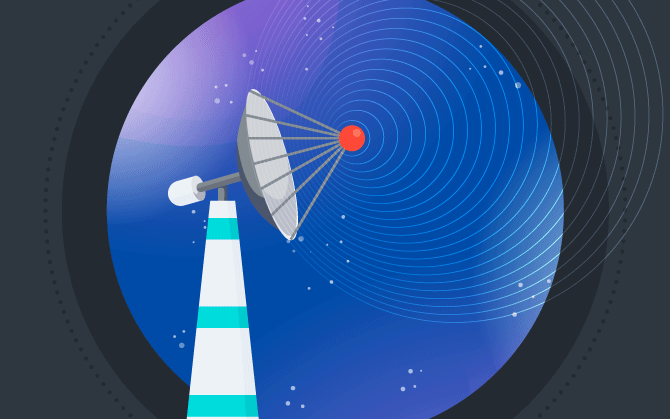
Broadcasting: What It Is And How To Use It For Your Business
Understand how this technology has changed the way media content is distributed.

What will we see in this post
We can all agree that globalization and digital transformation have changed the way information is shared. One of the ways that have profoundly changed how media content is distributed is Broadcasting.
In 2005, when YouTube was in its infancy, crawling towards becoming the phenomenon it is today, the word broadcast appeared in the platform’s slogan: “YouTube: broadcast yourself”.
Over time, the internet evolved, radically transforming how people communicate. Nowadays, we have 4G technology on our phones, some locations already have 5G. However, this progress is only beginning.
Along with the development of the 4G system, as well as improvements behind connection and content-sharing services on the internet, there’s the development of a few other technologies.
In this article, we’re going to focus on one of these technologies: Broadcasting.
Learn about this concept, how it works, and its importance to your company’s marketing.
What is broadcasting, anyway?
We can say that broadcasting boils down to the process by which information is transmitted or disseminated at the same time to several different receivers.
Broad means widespread or large in scale, while cast, in this case, means to transmit. Therefore, broadcasting can be defined as a widespread transmission or the streaming of content.
In Internet terms, transmission is the same as a broadcast, be it music or videos. Depending on the scale in which the network allows the content to be transmitted.
Moreover, TV and radio are examples of broadcasting means of communication.
Transmitting antennas sent the TV or radio signal by means of electromagnetic waves to the TV or radio devices that capture the signal.
In short, broadcasting can be understood as the act of “transmitting media content on a large scale”.
Do not confuse broadcasting with similar terms
Certain terms are treated as synonymous with broadcasting, but they are different concepts and therefore, cannot be confused. Below are a few of them.
a) Live Broadcast
Consists of a live transmission of content. Basically, it’s the same thing as Live Streaming.
b) Podcast
Involves shared audio files. It’s usually a complex and well-produced audio content.
c) Unicast
A unicast is when there’s one transmitter and one receiver.
d) Multicast
When there’s a single transmitter for several selected receivers.
e) Webcast
When media streaming is used in the transmission of audio and video.
f) Vodcast
The form of distributing videos over a computer network via the internet.
Types of Broadcast
There are two ways to broadcast: directed and limited broadcasting. The type depends basically on the router’s settings and to whom the broadcast is directed.
1. Directed broadcast
Occurs when a directed broadcast is sent to various hosts of a specific network.
It’s used to broadcast to the hosts of a local network. For example, the computers on an internal network of a company with several offices.
2. Limited broadcast
Limited transmission is used for limited communication with the hosts on a local network. They always use the destination IPv4 address 255.255.255.255.
Limited transmissions are not sent by the routers. For this reason, an IPv4 network is also called broadcast domain. Routers are edge devices, used for a certain broadcast domain.
During the transmission of a package, a network resource is used, causing the receiving host to process it. In this case, the broadcast traffic is limited, so that no negative effects arise regarding the performance of the network or of other devices.
How does broadcasting work and what is its importance?
Currently, the “mission” of broadcasting is to democratize the transmission of videos and other media content.
The basic idea is that, due to the pace and scope of the development and distribution of technologies such as smartphones, not even major global brands will be able to handle hundreds of millions of users at the same time and all over the world.
Democratizing technology means reducing the cost of production and distribution, at an affordable price for anyone in the world.
The world has already seen this happen with Twitter and Blogger, which ended up allowing anyone to reach a global audience immediately.
The same has happened with photos, through Flickr and Facebook; and with videos, through the rise of YouTube. These services have created the individualization of broadcasting, from a perspective of content creation and consumption.
Prior to these innovations, when it came to broadcasting, costs were at a level where only a few well-funded organizations were able to produce and distribute their content.
High production and distribution costs meant that you needed a large audience in order to cover expenses. As a result, you needed to produce content for the lowest common denominator.
The introduction of broadcasting has changed all of that. If costs can be reduced to the price of a smartphone and a 4G connection with the internet, people can broadcast and choose what they want to watch.
With the rapid advance over the last seven years and a growing number of easy-to-use streaming services, we see people sharing everything from cute puppies to coffee mugs.
Moreover, traditional media companies are also using new technologies to track news around the world and sharing it with their audience.
However, most technologies arrive in two waves. The first wave makes the technology available for use and is often considered to have the potential to revolutionize.
But product design is often dictated and restricted by the technology itself, and the real impact is initially on a limited scale. The first wave depends on the capabilities of the technology and it lives on a promise of what is to come.
The second wave, on the other hand, is about the actual use of the technology and an ecosystem. For example, in terms of broadcasting live mobile video, points such as processing power, mobile network capacity, data costs, and its distribution must be addressed.
It is from this point that technology matures and has the capacity to reach a common audience and demand.
The mission to democratize the broadcasting of content is much more than making the technology available and accessible. It’s also about valuing and empowering the democracy of access and the dissemination of information itself.
And how about you? Do you want to take advantage of this new scenario and start broadcasting your company’s content live?
Now, check out how to create a live stream using YouTube Super Chat.




